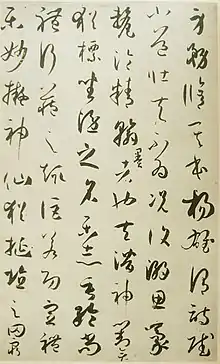Sun Guoting
Sun Guoting (simplified Chinese: 孙过庭; traditional Chinese: 孫過庭) (646–691) or Sun Qianli (孫虔禮),[1] was a Chinese calligrapher of the early Tang Dynasty, remembered for his cursive calligraphy and his Shu Pu (書譜, "A Narrative on Calligraphy" or "Treatise on Calligraphy" (ca. 687)). The work was the first important theoretical work on Chinese calligraphy, and has remained important ever since, though only its preface survived. The preface is the only surviving calligraphic work of Sun, therefore it is responsible for both Sun's reputation as an artist and as a theorist. The original handscroll can be seen at the National Palace Museum, in Taipei, Taiwan, and on its web site.

Part of the Treatise on Calligraphy
Notes
- It is not known whether Guoting was his name and Qianli his courtesy name, or the other way around.
References
- Two Chinese Treatises on Calligraphy: Treatise on Calligraphy (Shu pu) by Sun Qianli; Sequel to the "Treatise on Calligraphy" (Xu shu pu) by Jiang Kui; Yale University Press, 1995; ISBN 0-300-06118-8.
- Zhu, Guantian, "Sun Guoting". Encyclopedia of China, 1st ed.
External links
| Wikimedia Commons has media related to Sun Guoting. |
- National Palace Museum web site entry on the Treatise on Calligraphy, with full high-resolution scan of the complete work
- Answers.com Art Encyclopedia entry on Sun Guoting
- Modelling and English Translation of Sun Guoting's "A Narrative on Calligraphy" - Annotated translation and introduction of Shu Pu (A Narrative on Calligraphy).
- English translation of a brief excerpt of the Treatise on Calligraphy
This article is issued from Wikipedia. The text is licensed under Creative Commons - Attribution - Sharealike. Additional terms may apply for the media files.